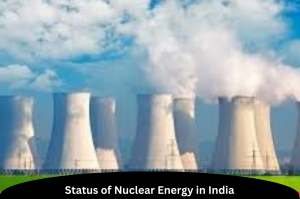Nuclear energy has emerged as a cornerstone of India’s quest for energy security, sustainable development, and technological leadership. With a growing population and rapid industrialization, India’s energy demand is projected to double by 2040. Nuclear energy, with its low carbon footprint and high energy density, offers a viable solution to meet this demand while aligning with global climate goals. India’s three-stage nuclear program, centered on uranium, plutonium, and thorium, is a testament to its long-term vision for energy independence. From powering homes to propelling submarines and advancing space exploration, nuclear energy is integral to India’s strategic, economic, and scientific aspirations.

What is the present status of Nuclear Energy in India?
| Civil Nuclear Power | Number of Operational Nuclear Power Plants- India has 22 operational nuclear reactors with a total installed capacity of 7,480 MW (as of 2024). New Nuclear Projects- Several new reactors are under construction, including Kudankulam (Units 3-6), Gorakhpur Haryana Anu Vidyut Pariyojana, and Kaiga Units 5 & 6, expected to add nearly 7,000 MW in the next decade which will add 8,000 MWe by 2031. Indigenous Reactor Technology- India has developed Pressurized Heavy Water Reactors (PHWRs), Prototype Fast Breeder Reactor (PFBR), and is progressing towards thorium-based Advanced Heavy Water Reactor (AHWR). |
| Nuclear in Defense | Nuclear-Powered Submarines- India has developed INS Arihant, the country’s first indigenous nuclear-powered ballistic missile submarine (SSBN), and is working on INS Arighat and additional units. Nuclear-Capable Missiles- India has a range of nuclear-capable missiles, including Agni (I-V), Prithvi, and K-15 (Sagarika). Nuclear Research and Collaborations- India collaborates with the IAEA, Russia (Rosatom), and the US (123 Agreement) for nuclear technology exchange, while advancing indigenous research at BARC, IGCAR, and NPCIL. |
| Technologies in Use and Development | PHWRs- The backbone of India’s nuclear program, using natural uranium as fuel. Fast Breeder Reactors (FBRs)- The 500 MWe Prototype Fast Breeder Reactor (PFBR) is under development, aiming to use plutonium and thorium for fuel. Molten Salt Reactors (MSRs)- It is still in the research phase, focusing on thorium utilization. Small Modular Reactors (SMRs)- These reactors are being explored for deployment at retiring coal plant sites. |
What is the significance and importance of Nuclear Energy?
1. Energy Security- The three-stage nuclear program aims to utilize thorium, ensuring long-term energy independence. Nuclear power accounts for about 3% of India’s electricity generation but is targeted to reach 22% by 2050.
2. Clean Energy- Nuclear power is a low-carbon energy source, contributing to India’s Net Zero by 2070 goal. It complements renewable energy by providing base-load power, ensuring grid stability.
3. Space Exploration- Nuclear energy powers radioisotope thermoelectric generators (RTGs) for deep-space missions, such as Chandrayaan and Mangalyaan.
4. Defence- Nuclear-powered submarines and missiles enhance India’s strategic deterrence and second-strike capability. Indigenous development of nuclear reactors and weapons reduces dependency on foreign technology.
5. Medical Advancements- BARC-developed radiopharmaceuticals aid in cancer treatment, with India producing over 50 radioisotopes for medical use.
6. Food Preservation- Nuclear technology enhances food irradiation, increasing shelf-life and preventing spoilage.
What have been the government schemes for the promotion of Nuclear Energy?
| Three-Stage Nuclear Program | Stage 1: PHWRs using natural uranium. Stage 2: Fast Breeder Reactors using plutonium and thorium. Stage 3: Thorium-based reactors for sustainable energy. |
| Bharat Small Reactors (BSR) | It aims to deploy small modular reactors in collaboration with the private sector. |
| International Collaborations | Indo-US Nuclear Deal- Facilitated access to global uranium markets and advanced technologies. Civil Nuclear Cooperation Agreements- Signed with Russia, France, USA, Japan, and others for fuel supply and technology transfer. Nuclear Insurance Pool (2016)- Mitigates risks associated with nuclear energy projects. |
What are the Challenges associated with Nuclear Energy?
1. Technological and Infrastructure Challenges
a. High Initial Costs- Nuclear plants require significant capital investment compared to coal or renewables.
b. Limited Indigenous Uranium Supply- Dependence on imports hinders energy security.
c. Delayed Project Completions- Kudankulam and PFBR projects have faced repeated delays.
2. Safety and Environmental Concerns
a. Radiation Risks- Safety concerns post-Fukushima impact public perception.
b. Nuclear Waste Management- India lacks robust long-term nuclear waste disposal mechanisms.
3. Regulatory and Political Challenges
Public Opposition- Protests in Tamil Nadu and Maharashtra have stalled nuclear projects.
Policy Uncertainty- Frequent changes in regulations delay private sector participation.
4. Geopolitical Constraints
NSG Membership Roadblock- India’s non-signatory status to the NPT limits access to advanced nuclear technologies.
Global Uranium Market Volatility- Prices and supply chain disruptions affect India’s nuclear fuel procurement.
What should be the Way Forward?
1. Accelerate Thorium-Based Reactors- Given India’s vast thorium reserves, fast-tracking AHWR deployment is crucial for the growth of nuclear energy.
2. Enhancing Private Sector Involvement- Allowing greater participation of companies like L&T, Tata, and Reliance in nuclear infrastructure can boost innovation.
3. Expanding Public Awareness and Transparency- Addressing misconceptions through public engagement can improve acceptance.
4. Strengthening Global Collaborations- Expanding partnerships with France, Russia, and the US for technology exchange and uranium supply.
5. Developing Small Modular Reactors (SMRs)- Investing in indigenous SMR designs can complement large nuclear plants.
6. Focus on Nuclear Waste Management- Setting up deep geological repositories for spent nuclear fuel.
7. Leveraging AI and Digital Tools- Integrating AI-driven safety systems and predictive maintenance can enhance reactor efficiency.
India’s nuclear energy program is not just about powering homes; it is about powering the nation’s aspirations. From ensuring energy security to advancing space exploration and strengthening national defence, nuclear energy is a strategic asset for India. The journey from uranium to thorium symbolizes India’s transition from energy dependence to energy independence. With bold initiatives, technological innovation, and strategic collaborations, India is poised to harness the full potential of nuclear energy. As the world moves toward a low-carbon future, India’s nuclear energy program stands as a beacon of sustainable development and technological leadership. The dream of “Viksit Bharat” is not just a vision; it is a mission powered by the atom.
| Read More- The Indian Express UPSC Syllabus- GS 3- Science and Technology |
Discover more from Free UPSC IAS Preparation Syllabus and Materials For Aspirants
Subscribe to get the latest posts sent to your email.






